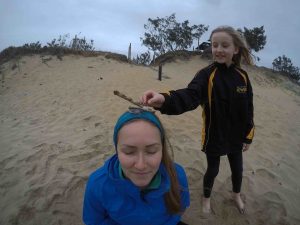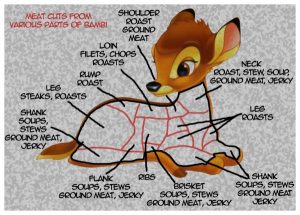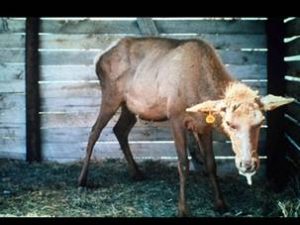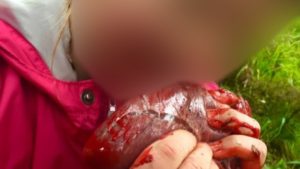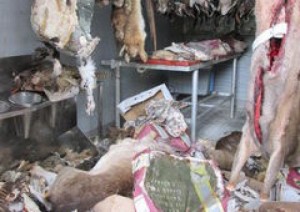In May 2016, an outbreak of Shiga toxin–producing Escherichia coli O157 infections occurred among children who had played in a stream flowing through a park. Analysis of E. coli isolates from the patients, stream water, and deer and coyote scat showed that feces from deer were the most likely source of contamination.
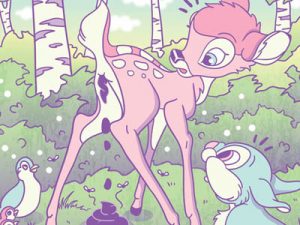 In the United States, recreational water is a relatively uncommon source of Shiga toxin–producing Escherichia coli (STEC) O157 outbreaks (1). We describe an outbreak of STEC O157 infections among children exposed to a contaminated stream in northern California, USA, and provide laboratory evidence establishing wildlife as the source of water contamination.
In the United States, recreational water is a relatively uncommon source of Shiga toxin–producing Escherichia coli (STEC) O157 outbreaks (1). We describe an outbreak of STEC O157 infections among children exposed to a contaminated stream in northern California, USA, and provide laboratory evidence establishing wildlife as the source of water contamination.
In May 2016, four cases of Shiga toxin (Stx) 1– and 2–producing E. coli O157 infection were reported to a local health department in northern California; investigation revealed a common source of exposure. The case-patients, ranging in age from 1 to 3 years, had played in a stream adjacent to a children’s playground within a city park. Exposure of the case-patients to the stream occurred on 3 separate days spanning a 2-week period. Two case-patients are known to have ingested water while playing in the stream. Two case-patients were siblings. All case-patients had diarrhea and abdominal cramps; bloody diarrhea was reported for 3. One case-patient was hospitalized with hemolytic uremic syndrome.
The stream is a second-order waterway located in a northern California community of ≈7,500 residents. At the time of exposures, stream flow was <30 ft3/s. The land upstream is not used for agricultural activities such as livestock production. The community is serviced by a public sewer system; inspection of sewer lines indicated no breach to the system.
Water samples were collected from the exposure site 7 days after the last case-patient was exposed and weekly thereafter for 17 weeks; samples were tested quantitatively for fecal indicator organisms. Throughout the study period, all water samples exceeded recreational water quality limits for E. coli and enterococci levels (2). Water samples were also cultured for STEC isolation and PCR detection of stx1 and stx2 (3). Stx1- and Stx2-producing E. coli O157 were isolated from stream water each week for the first 4 weeks. Additionally, an Stx2-producing E. coli non-O157 strain was isolated from the stream in the first week of sampling. Enrichment broth cultures of water samples were also positive by PCR for stx1 and stx2 for the first 4 weeks of sampling. Thereafter, both stx1 and stx2, or stx2 only, were intermittently detected in enrichment broth cultures for 9 additional weeks.
In the absence of an obvious source (e.g., upstream agricultural operation or sewer leak), wildlife was considered as a possible contributor to water contamination. Thirteen fresh wildlife scat specimens were collected along the stream for STEC culture and PCR. Of the 13 scat specimens, 8 originated from deer, 2 from raccoon, and 1 each from coyote, turkey, and river otter. Six scat specimens (4 deer, 1 coyote, 1 river otter) were positive for stx1 and stx2 or for stx2 by PCR (Technical Appendix[PDF – 16 KB – 1 page]). Stx1- and Stx2-producing E. coli O157 were isolated from deer scat and coyote scat. An Stx2-producing E. coli non-O157 strain was isolated from a deer scat specimen. The animal origin of the coyote and river otter scat specimens were definitively identified by partial DNA sequencing of mitochondrial cytochrome b (4).
To assess strain relatedness, we compared STEC O157 isolates from the case-patients, water, deer scat, and coyote scat by using pulsed-field gel electrophoresis (PFGE) and multilocus variable-number tandem-repeat analysis (MLVA) (5). PFGE patterns for XbaI-digested genomic DNA were highly similar among all isolates; only slight variations were found in the lower-sized bands (Figure). PFGE patterns for genomic DNA samples digested with BlnI also demonstrated a high degree of similarity (data not shown). Furthermore, MLVA profiles were identical for the case-patient, water, and deer scat isolates; only the coyote scat isolate differed from the main profile by 2 repeats at a single locus (VNTR_3).
This study provides laboratory evidence linking STEC O157 infections with the ingestion of recreational water that was probably contaminated by wildlife scat. Wild ruminants, including deer and elk, are known carriers of STEC and have been connected to outbreaks of human infections (6–9). We detected STEC in 50% of deer scat specimens collected from the stream bank. One of these specimens, found 1.5 miles upstream of the exposure site, contained an E. coli O157 isolate that was highly similar by molecular subtyping to case-patient and water isolates. These findings support the likelihood that feces from deer carrying STEC were the source of water contamination or, at the very least, contributed to the persistence of STEC in the water. It is unknown whether the STEC detected in coyote and river otter scat represents carriage or transitory colonization within these animals.
The common risk factor among the case-patients in this STEC O157 outbreak was exposure to a natural stream within a city park. After the outbreak was recognized, signs warning of bacterial contamination were posted along the stream. No further STEC O157 infections attributed to stream water exposure were reported.
Dr. Probert is the assistant director for the Napa-Solano-Yolo-Marin County Public Health Laboratory. His research interests focus on the development of molecular diagnostic tools for the detection of infectious agents.
Acknowledgment
We thank Frank Reyes, Keith Snipes, and Nailah Souder for their technical assistance; the County of Marin Health and Human Services and Environmental Health Services for information about the epidemiologic and environmental investigation; and the Microbial Diseases Laboratory Branch of the California Department of Public Health and the Santa Clara County Public Health Laboratory for the molecular subtyping data.
References
Heiman KE, Mody RK, Johnson SD, Griffin PM, Gould LH. Escherichia coli O157 outbreaks in the United States, 2003–2012. Emerg Infect Dis. 2015;21:1293–301. DOIPubMed
United States Environmental Protection Agency. 2012. Recreational water quality criteria. Office of Water 820-F-12–058 [cited 2017 Apr 13]. https://www.epa.gov/sites/production/files/2015-10/documents/rwqc2012.pdf
Probert WS, McQuaid C, Schrader K. Isolation and identification of an Enterobacter cloacae strain producing a novel subtype of Shiga toxin type 1. J Clin Microbiol. 2014;52:2346–51. DOIPubMed
Parson W, Pegoraro K, Niederstätter H, Föger M, Steinlechner M. Species identification by means of the cytochrome b gene. Int J Legal Med. 2000;114:23–8. DOIPubMed
Hyytia-Trees E, Lafon P, Vauterin P, Ribot EM. Multilaboratory validation study of standardized multiple-locus variable-number tandem repeat analysis protocol for Shiga toxin–producing Escherichia coli O157: a novel approach to normalize fragment size data between capillary electrophoresis platforms. Foodborne Pathog Dis. 2010;7:129–36. DOIPubMed
Fischer JR, Zhao T, Doyle MP, Goldberg MR, Brown CA, Sewell CT, et al. Experimental and field studies of Escherichia coli O157:H7 in white-tailed deer. Appl Environ Microbiol. 2001;67:1218–24. DOIPubMed
Keene WE, Sazie E, Kok J, Rice DH, Hancock DD, Balan VK, et al. An outbreak of Escherichia coli O157:H7 infections traced to jerky made from deer meat. JAMA. 1997;277:1229–31. DOIPubMed
Rounds JM, Rigdon CE, Muhl LJ, Forstner M, Danzeisen GT, Koziol BS, et al. Non-O157 Shiga toxin–producing Escherichia coli associated with venison. Emerg Infect Dis. 2012;18:279–82. DOIPubMed
Laidler MR, Tourdjman M, Buser GL, Hostetler T, Repp KK, Leman R, et al. Escherichia coli O157:H7 infections associated with consumption of locally grown strawberries contaminated by deer. Clin Infect Dis. 2013;57:1129–34. DOIPubMed
Contaminated stream water as source for Escherichia coli O157 illness in children
05.may.17
William S. Probert, Glen M. Miller, and Katya E. Ledin
Emerging Infectious Diseases, vol. 23, no. 7, July 2017
https://wwwnc.cdc.gov/eid/article/23/7/17-0226_article
 Six of the 10 hunters had similar symptoms and illness onset dates. Serologic tests indicated a recent toxoplasmosis infection for all symptomatic hunters, and the risk factor identified was consumption of undercooked deer meat. Among asymptomatic hunters, 2 were already immune to toxoplasmosis, 1 was not immune, and the immune status of 1 remains unknown. Outbreaks of acute toxoplasmosis infection are rare in North America, but physicians should be aware that such outbreaks could become more common.
Six of the 10 hunters had similar symptoms and illness onset dates. Serologic tests indicated a recent toxoplasmosis infection for all symptomatic hunters, and the risk factor identified was consumption of undercooked deer meat. Among asymptomatic hunters, 2 were already immune to toxoplasmosis, 1 was not immune, and the immune status of 1 remains unknown. Outbreaks of acute toxoplasmosis infection are rare in North America, but physicians should be aware that such outbreaks could become more common.



